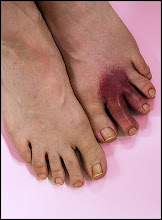Monkey Sees
View PhotoTell me if I'm right or wrong: I think what you're after here, and in many of your other photos, is the non-emotive, rational world that underlies the highly emotion-laden world we live in at sense-perception level.
The human-as-monkey can't see any-damn-thing without relating it to sex and/or food. We react to the colour erd because it means ripe fruit and/or dangerous beasties and plants (and maybe sex too – lips and labia). And so on. I think your photos try to break that connection and show the world as if it had no meaning except the mathematical. So here we have circles and lines. And many of your other photos have the same focus.
And yet...well, this does in fact have emotive power. Did you intend that? Like a Jackson Pollock painting. Tho I've never been fond of Jack the Dripper myself. But there's always emotion out there...because after all, we remain monkeys.
My response:
P.C. – thanks for what's certainly one of the most perceptive comments I ever got. You've articulated something that's central to the way I see. It would be dangerous for me to say Yea or Nay to your query, since ambiguity and polysemy are the generative organs of art, and it wouldn't do to clog them up with commitment. But I will say, and hope others see, that there's a confusion in human people between thinking and feeling, which are as hard to unscramble as a scrambled egg, and that I try to bring that confusion into focus.
I've seen mathematicians weep for the beauty of number. Romantics who talk about the cold, unfeeling, bean-counting, unmagical, materialistic world of reason are like children whose deepest emotion is their love for Santa and his toys.
I have a sweet tooth for the truth, and there's nothing sweeter than sweet reason.

